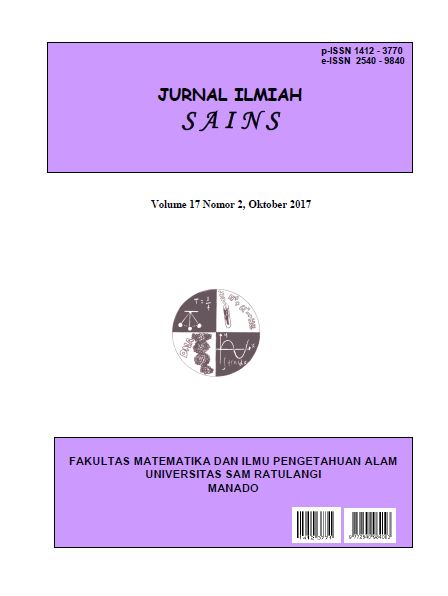PERBANDINGAN YIELD NERACA MASSA HASIL PRETREATMENT TIGA JENIS LIMBAH LIGNOSELULOSA DALAM MEMPRODUKSI POLISAKARIDA MENGGUNAKAN TEKNIK KIMIAWI
DOI:
https://doi.org/10.35799/jis.17.2.2017.17348Abstract
PERBANDINGAN YIELD NERACA MASSA HASIL PRETREATMENT TIGA JENIS LIMBAH LIGNOSELULOSA DALAM MEMPRODUKSI POLISAKARIDA MENGGUNAKAN TEKNIK KIMIAWI
ABSTRAKLimbah lignoselulosa merupakan jenis limbah yang mengandung lignin, selulosa dan hemiselulosa (xilan). Pada lignoselulosa, senyawa yang dapat dimanfaatkan adalah hemiselulosa dan selulosa, sedangkan lignin dihilangkan. Hemiselulosa dan selulosa sebagai polisakarida dapat digunakan sebagai substrat dalam produksi enzim maupun hidrolisis secara kimia, proses tersebut dilakukan untuk mendapatkan gula yang lebih sederhana. Penelitian sebelumnya telah dilakukan ekstraksi xilan dari ampas tebu, hasil samping dari ekstraksi tersebut adalah selulosa. Oleh karena itu, penelitian ini telah membandingkan hasil ekstraksi xilan dan selulosa dalam satu jenis limbah dan membandingkan hasil keduanya diantara 3 jenis limbah lignoselulosa menggunakan metode yang sama. Penelitian ini bertujuan untuk mengekstraksi polisakarida xilan dan selulosa yang terkandung di dalam limbah ampas tebu, tongkol jagung dan jerami padi. Metode penelitian yang digunakan adalah pretreatment secara kimiawi yakni delignifikasi dengan 1 % NaOCl (v/v), ekstraksi xilan dan selulosa dengan metode alkali menggunakan 15 % NaOH pekat dan purifikasi xilan dengan 4% NaOH (v/v). Adapun target yang telah dicapai adalah perolehan polisakarida terbanyak akan digunakan sebagai bahan utama untuk memproduksi enzim. Hasil perolehan yield pada masing-masing neraca massa menunjukkan bahwa, jumlah rendemen xilan terbanyak yaitu jerami sebanyak 110 g dengan penurunan massa dari proses sebelumnya sebesar 61,5%, sedangkan untuk rendemen selulosa diperoleh juga oleh jerami yaitu sebanyak 330 g dengan penurunan massa dari proses sebelumnya sebesar 39,5% . Hal tersebut menunjukkan bahwa jumlah terbanyak pada rendemen xilan berbanding lurus dengan jumlah selulosa. Kesimpulan tersebut di perkuat dengan hasil pada dua jenis limbah lainnya, yakni berbanding lurus. Perolehan rendemen hasil purifikasi terbanyak yaitu ampas tebu (bagas) sebesar 86 gr dengan persentase penurunan massa hanya sebesar 14%.
Kata kunci: Lignoselulosa, Delignifikasi, Ekstraksi, Xilan, Selulosa.
Â
COMPARISON OF YIELD BALANCE MASS RESULT OF PRETREATMENTT THREE TYPES OF LIGNOSELULOSA WASTE IN PRODUCING POLYSACCHARIDE USING CHEMICAL ENGINEERING
ABSTRACT
Lignocellulosic waste is a type of waste containing lignin, cellulose and hemicellulose (xylan). In lignocellulose, the compounds that can be utilized are hemicellulose and cellulose, whereas lignin is removed. Hemicellulose and cellulose as polysaccharides can be used as substrates in the production of enzymes and hydrolysis chemically, the process is carried out to obtain simpler sugars. In a previous research, the extraction of xylan from bagasse, a by-product of the extraction, was cellulose. Therefore, this research compared the results of xylan and cellulose extraction in one type of waste and compare the results of the two between 3 types of lignocellulosic waste using the same method. This research aims to extract polysaccharide xylan and cellulose contained in waste bagasse, corn cob and rice straw. The research method used was chemical pretreatment ie delignification with 1% NaOCl (v/v), xylan extraction and cellulose by alkali method using 15% concentrated NaOH and purification of xylan with 4% NaOH (v/v). The target to be achieved is the acquisition of the most polysaccharides will be used as the main ingredient for producing enzymes. The yield of mass balance shows that the highest amount of xylan content is 110 g with the mass decrease from the previous process of 61.5%, while for cellulose rendemen is also obtained by straw as much as 330 g with the decrease of mass from process previously amounted to 39.5%. This shows that the largest amount of xylan content is proportional to the amount of cellulose. The conclusions are reinforced with the results of two other types of waste, which are directly proportional. The highest yield of purification result is bagasse equal to 86 gr with percentage of mass decrease only 14%.
Keywords: Lignocellulose, Delignification, Extraction, Xylan, Cellulose.
Â
Â
References
Chapman, J.S. 2003. Biocide resistance mechanisms. Int Biodeter Biodegr. 51:133- 138.
Beg, Q.K., M. Kapoor, L. Mahajan, and GS. Hoondal. 2001. Microbial xylanases and their industrial applications: a review, Appl Microbiol Biotechnol. 56:326–338.
Gray, K.A, Zhao L, Emptage M. 2006. Bioethanol. Chem Bio J. 10:141-146.
Iranmahboob, J., F. Nadim, and S. Monemi, 2002, Optimizing acid-hydrlysis: a critical step for production of ethanol from mixed wood chips, Biomass and Bioenergy. 22: 401-404.
Lee, Y.J. 2003. Oxidation of sugarcane bagas using a combination of hypochlorite and peroxide [Thesis], Korea (KR): Submitted to The Graduate Faculty of theLouisiana State University dan Agricultural dan Mechanical College.
Richana, N. 2002. Produksi dan prospek enzim xilanase dalam pengembangan bioindustri di Indonesia, Buletin AgroBio. 1:29-36.
Richana, N., T.T. Irawadi, MA Nur, MA., Sailah, I., Syamsu, K., and Arkenan, Y. 2007. Ekstraksi xilan dari tongkol jagung. J. Pascapanen. 4(1):38-43.
Riyanti, E.I. 2008. Biomassa sebagai bahan baku bioethanol. J Litbang Pertan. 28(3).
Sudiyani, Y., Heru R., Alawiyah, S. 2010. Pemanfaatan biomassa limbah lignuselulosa untuk bioetanol sebagai sumber energi baru terbarukan. Ecolab. 4(1):1-54.
Sun, Y., and Cheng, J. 2002. Hydrolysis of lignocellulosic materials for ethanol production: a review. Biores Technol.83:1-11.
Su, Z.Q., Bu, L.X., Zhao,D.Q., Sun, R.C., and Jiang J.X. 2012. Processing lespedeza stalks by pretreatment with low severity steam and post treatment with alkaline peroxide. Industrial Crops and Product.36, 1-8.







